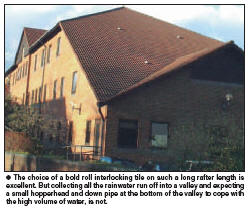 |
 |
 |
 |
 |
 |
 |
|
Check out our web directory of the UK
roofing and cladding industry
www.roofinfo.co.uk |
Sign up for our monthly news letter. |
|
|
|
 During a deluge of rain, water will wet
everything in its path equally. However some surfaces will get wetter
than others. One square metre of horizontal surface will receive more
rainwater than one square metre of sloping surface at 45º. In theory
one square metre of vertical wall should hardly get wet at all.
Water flow
Look closely at a sloping roof surface and rainwater falling on the
ridge will always be minimal, but each course of tiles below the ridge
will receive progressively more water flow, as further rainfall is added
to the water running down the roof slope. The longer the roof slope the
greater will be the volume of water flowing over the eaves.
Pitch
The pitch of the roof will also affect the volume of water flowing
over the eaves. The steeper the roof slope the less time the rainwater
will take to reach the eaves. The shallower the roof slope the longer it
will take for the rainwater to reach the eaves and the greater will be
the volume of rainfall added to the water flowing down the roof slope
during its journey.
Texture
A rough surface texture to the roof can also slow up the water run
off; therefore it is better to have a smooth surface texture for shallow
roof slopes.
Wind driven rain
Whilst the design rainfall rate that is used for a 'once in 50 year
event@ is expressed as 225mm depth of rain on a horizontal surface
during a one hour period, deluge rain storms tend to have a duration of
less than one hour. Therefore the intensity of the rainfall may be far
in excess of the 225mm/hr at the deluge peak. Whilst wind driven rain
contains less water than a deluge with no wind, the higher the wind
speed the less water falls, however the wind can blow water up a roof
and slow up the water run off.
Rainwater blown onto a nonporous wall
surface will drain off. If there is a roof slope below, the added water
run off could produce high localised volumes of water that could exceed
the maximum deluge rainfall rate.
|

|
|
This is also true of rainwater pipes, or
inclined valleys, from higher roofs discharging onto lower roof slopes.
They should be avoided or reduced where possible.
Side interlock
The effect of high volumes of water flowing down a shallow roof
slope with a long rafter length can generate flows of up to 15mm deep.
If water starts to back up, due to obstructions, restrictions or gaps,
it will try and find a way through the roof covering. Where the side lap
joints in the roof covering are at a high point, as with some bold roll
interlocking tiles, there is a reduced risk of water penetration. But
where the side lap joint is at the lowest point, as with a flat
interlocking tile, there is a much higher risk of water penetration. The
minimum pitch/maximum rafter length will vary with each tile design and
manufacturer and this information should be available from the roof tile
manufacturers literature.
Prevention
To ensure that high water flows down a roof slope with a long rafter
length do not become a problem, the following precautions should be
taken:
- Rafter pitch should be as steep as
possible,
- Rafter length should not exceed the
recommendations of the tile manufacturer,
- Water run off from higher roofs, walls
or valleys should be reduced or drained away separately, and not
discharged onto lower roof slopes.
- A tile with a side interlock
positioned as high above the pan of the tile as possible should be
used
|
|
Compiled by Chris Thomas, The Tiled
Roofing Consultancy, 2 Ridlands Grove, Limpsfield Chart, Oxted, Surrey,
RH8 0ST, tel 01883 724774 |
|